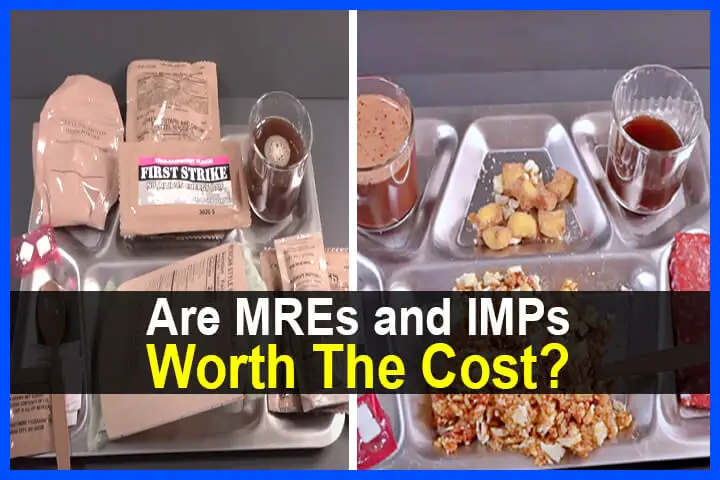Estimated reading time: 8 minutes
In an unpredictable world where natural disasters, military operations, or even weekend camping trips can turn survivalist, ready-to-eat emergency meals become more than just a convenience – they become a necessity.
Meals Ready to Eat (MREs) and Individual Meal Packs (IMPs) represent the pinnacle of this innovation, offering nutritious, long-lasting, and compact food options that can be consumed with minimal preparation.
In scenarios where cooking facilities are scarce or non-existent, their significance skyrockets. Both MREs and IMPs are designed to withstand harsh conditions, providing sustenance and energy when it’s needed most, be it in the heart of a conflict zone, amidst the rubble of an earthquake, or on a remote hiking trail.
Want to save this post for later? Click Here to Pin It On Pinterest!
What Are MREs? (Meals Ready to Eat)
There are several reasons why MREs are favored by outdoor enthusiasts. A key factor is the convenience they provide – MREs require no cooking, are easily consumed while on the go, and have a long shelf life.
This feature makes them ideal for camping, hiking, and other outdoor activities where carrying cooking equipment is impractical. In addition, MREs offer a diverse menu, catering to a variety of tastes and dietary preferences.
The Genesis and Evolution of MREs
MREs were first introduced by the U.S. Department of Defense in the 1980s as a replacement for canned wet rations. Since then, they have evolved significantly, not only in terms of menu variety but also in the quality and nutritional content. Today’s MREs are designed to provide a balanced diet, maintaining the energy level of soldiers in the field, or outdoor enthusiasts exploring nature.
Anatomy of an MRE

A typical MRE pack contains a main meal, a side dish, snacks, and a drink mix. The main meals range from traditional dishes like beef stew or spaghetti to more exotic options such as chicken curry. Sides often include rice, mashed potatoes, or fruit. Snacks can be energy bars, cookies, or candy.
Some packs also contain accessories like utensils, napkins, and a heating element to warm the main meal. Despite their compact size, MREs are packed with essential nutrients to sustain an active lifestyle.
Exploring IMPs (Individual Meal Pack)
Individual Meal Packs (IMPs) are the Canadian military’s answer to the field ration. Similar to MREs, IMPs provide a nutritionally complete, ready-to-eat meal for soldiers in field operations where full kitchen facilities are unavailable.
IMPs: Canada’s Answer to Field Rations
Introduced by the Canadian Department of National Defence in the 1980s, IMPs are designed to sustain military personnel during intensive operations. Not only are they easy to carry, but they are also designed to withstand extreme conditions and have a shelf life of up to three years.
Initially, IMPs had a limited range of meal options. However, over time, this has evolved to reflect the diverse tastes and dietary needs of modern soldiers.
Breaking Down an IMP

An IMP pack typically contains a main entrée, a side dish, bread or crackers, dessert, and a drink mix. The main entrees range from hearty meals like Shepherd’s Pie to regional favorites like Poutine. Side dishes commonly include rice, pasta, or beans.
Extras such as ketchup, hot sauce, and peanut butter are also included alongside utensils, napkins, a heating element, and even a beverage bag for the drink mix. Despite their compact nature, IMPs offer a diverse menu, ensuring soldiers have the essential nutrients they need while out in the field.
MREs vs IMPs: Spotting the Differences
When comparing the American MREs and the Canadian IMPs, there are several key differences to note. This includes differences from packaging to meal choices, and from taste profiles to shelf life.
Packaging
While both MREs and IMPs come in lightweight, portable packaging, MREs typically come in a thick plastic pouch called a trilaminate retort pouch, while IMPs are packaged in a slightly larger, gusseted bag. Both are designed for ease of use in the field and can withstand extreme conditions.
Meal Choices and Taste Profiles
MREs offer a wider variety of meal choices, ranging from traditional American dishes like chili and macaroni. IMPs, on the other hand, have a more limited range but include regional favorites such as sausage and hash browns. Taste profiles vary, though IMPs can sometimes have a more home-cooked flavor compared to MREs.
Nutritional Benefits and Shelf Life
Both MREs and IMPs are nutritionally balanced to meet the needs of soldiers in the field. You can expect between 1200-1400 calories per meal MREs and IMPs have a similar calorie count, but MREs typically have a higher sodium content. As for shelf life, both can last for up to three years when stored properly.
Other Players in the Ready-to-Eat Emergency Meals Arena
- Freeze-Dried Meals: These are lightweight, compact, and have a long shelf life. They require rehydration with hot or cold water making them ideal for hiking, camping, and emergency preparedness.
- Canned Goods: Canned goods are a traditional method for preserving food. They are durable, have a long shelf life, and the range of available foods is extensive, making them a viable option for emergencies.
- Survival Food Kits: Typically, these kits include a variety of long-lasting, ready-to-eat foods in one package. They are designed for survival scenarios and disaster preparedness.
- Commercial Meal Packs: These are pre-packaged meals similar to MREs and IMPs, but typically designed for civilian use. They are great for outdoor activities and emergencies and offer a good balance of nutrition, taste, and convenience.
The Difference Between Military and Civilian Rations
While military rations such as MREs and IMPs are designed to withstand extreme conditions and to meet the high-calorie needs of soldiers in the field, civilian rations are typically geared more towards convenience and taste.
Civilian rations, such as commercial meal packs, often offer a wider variety of options, including dietary and allergen-friendly versions. However, they may not provide the same longevity or nutritional balance as their military counterparts. Also, civilian rations may require some degree of preparation or cooking, whereas military rations are usually ready to eat straight from the pack.
Pros and Cons of Ready-to-Eat Emergency Meals
Ready-to-eat emergency meals offer undeniable convenience, especially in high-stress, time-sensitive situations. They are pre-packaged, require minimal to no preparation, and provide a quick source of energy and nutrition. Despite their convenience, they do come with trade-offs.
The taste may not always be to everyone’s liking, and even though they strive to provide a balanced nutrition, they are often high in sodium and cannot replace a fresh, varied diet in the long run.
Cost-wise, they can be more pricey than traditional, home-prepared meals. Storage requirements are generally low, as they have a long shelf life and don’t require refrigeration, making them ideal for emergency preparedness, camping, and military use.
However, the environmental impact is a downside, as the packaging is typically single-use and not easily recyclable. Considering these factors can help determine the role these meals should play in one’s diet and emergency planning.
Stockpiling Ready-to-Eat Emergency Meals: A Wise Move?

Stockpiling ready-to-eat emergency meals can be a strategic decision, especially for residents in disaster-prone regions or individuals with active, outdoor lifestyles. These meals have a long shelf life, removing the concern of food spoilage during storage.
Although they can be more expensive than traditional meals, the life-saving convenience they offer in emergency situations justifies the cost. They require minimal storage space, making them a practical choice even for those with limited room.
Ultimately, the decision to stockpile should be made after evaluating individual needs, the frequency of potential emergencies, and the availability of alternative food sources.
Ideal Scenarios for the Use of Ready-to-Eat Emergency Meals
In various situations, ready-to-eat emergency meals prove to be an invaluable resource. Natural disasters such as hurricanes, earthquakes, or floods often disrupt normal living conditions, making cooking impossible. Power outages, too, can render traditional cooking methods useless, nudging families towards these meals.
For military personnel deployed in remote areas without access to fresh food supplies, these meals are a lifeline. Campers and adventurers, needing lightweight, no-fuss food options, often rely on ready-to-eat emergency meals.
They also play a crucial role in survival strategies for prepping and providing quick, nutritionally balanced food when every moment counts.
Final Thoughts
MREs and IMPs serve as a vital resource in many scenarios, including natural disasters, power outages, military operations, and outdoor adventures. Their long shelf life, compactness, and convenience make them a practical choice for varying needs.
Like this post? Don’t Forget to Pin It On Pinterest!

Read the full article here




